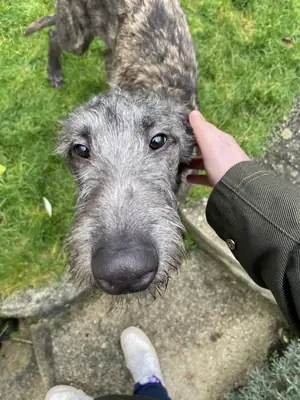Scottish Deerhound: Traits, Care, Nutrition, Health and 2026 Living Guide
The Scottish Deerhound is a gentle, athletic sighthound built for grace and endurance. In 2026, wearables, GPS training planners and joint-friendly home setups help guardians meet needs even in urban settings. This handbook walks from puppyhood through adulthood across space, exercise, diet and preventive health.
1. Breed Profile
- Origin: Scotland
- Weight/Height (approx): M 38–50 kg / 76–81 cm; F 30–43 kg / 71–76 cm
- Lifespan: 8–11 years
- Temperament: Calm, people‑oriented, strong prey drive, rapid sprinter
- Key needs: Soft resting surfaces, rhythmic walks, safe sprint opportunities
2. Housing & 2026 Climate Management
- Maintain 18–24°C indoors; provide shade and cooling mats in summer, draft‑free dry rooms in winter.
- Thick rugs/rubber tiles protect joints; lean body fat can predispose to pressure points.
- Raised water bowls and XL orthopedic beds improve comfort for long‑limbed frames.
- Smart doors/sensors can log night routines and outdoor access safely.
3. Exercise & Enrichment
3.1 Daily Volume
- 60–90 minutes total walking daily plus occasional free running in secure areas.
- Puppies/adolescents (to 18 months): short, frequent, low‑impact sessions; avoid repetitive jumping and sharp turns.
3.2 Mental Work
- Scent games, target work, calm puzzle tasks suited to sighthounds.
- Use 2026 GPS/IMU collars to review pace, load and recovery curves.
4. Nutrition Strategy
Prioritise lean mass maintenance, GI comfort around workouts and micronutrient diversity.
| Component | Target | Examples | Role |
|---|---|---|---|
| Protein | 24–28% (puppy/adolescent), 22–26% (adult) | Turkey, salmon, lamb, egg | Repair, lean mass |
| Fat | 12–16% (adjust to workload) | Fish oil, canola, flax | Omega‑3s, coat/joints |
| Complex carbs | Moderate | Oats, brown rice, sweet potato | Steady energy, GI tolerance |
| Micro/phyto | Targeted | Leafy greens, crucifers, berries | Antioxidants, gut balance |
| Functional extras | As needed | Glucosamine, chondroitin, MSM, probiotics | Joint and GI support |
Split into two meals; avoid large meals 2–3 h before and ≥1 h after hard efforts. Slow‑feed bowls and calm settings help reduce digestive upsets.
5. Health: Prevention & Screening
- Orthopedics: Low‑impact flooring and controlled workloads; keep body condition lean.
- Cardiac: Consider screening for cardiomyopathy; annual auscultation/echo.
- Oncology: Tall sighthounds may face osteosarcoma; investigate lameness promptly.
- GDV: Deep chest can elevate risk; manage meal size/timing and activity windows.
- Skin/pressure points: Thick bedding and rotation of resting spots.
- Anaesthesia sensitivity: Discuss tailored protocols for sighthounds with your vet.
6. Training & Behavior
- Gentle, reward‑based sessions; sighthounds respond to calm structure.
- Reinforce recall/wait/leave‑it to manage prey drive safely.
- Early socialisation with surfaces, sounds and controlled environments.
7. Travel & Gear
- Wide, non‑slip car setups and XL seat‑belt harnesses.
- Water/cooling breaks every 2 hours; avoid midday heat.
- Microchip + QR ID + GPS for redundancy.
8. Frequently Asked Questions
Apartment living?
Feasible with spacious layout, daily walks and access to secure run areas.
Daily exercise needs?
Generally 60–90 minutes; emphasise rhythmic walks and controlled sprints.
Injury prevention during runs?
Warm‑up/cool‑down, soft straight surfaces, gradual pace changes.
Lowering GDV risk?
Smaller meals, slow‑feed bowls, calm feedings, avoid intense work around meals.
Coat care routine?
Brush 2–3x weekly; use gentle products for rough, wiry coats.
Good with children/pets?
Typically gentle; supervise intros and manage space.
Best indoor surfaces?
Thick rugs or rubber tiles; avoid slick hardwood/marble.
Helpful supplements?
Glucosamine‑chondroitin, MSM, omega‑3s, probiotics (vet guidance).
Flight travel tips?
Cool‑hour flights, approved crates, hydration planning, minimise layovers.
What if sudden lameness occurs?
Stop activity, apply cold packs and schedule prompt veterinary assessment.
9. Conclusion
Soft surfaces, steady exercise, balanced nutrition and consistent screening form the foundation for Deerhound wellbeing in 2026.
